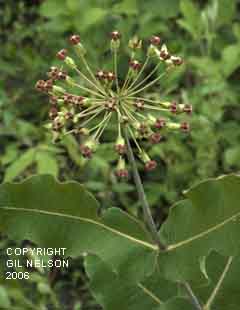Asclepias amplexicaulis
| Asclepias amplexicaulis | |
|---|---|

| |
| photo by Gil Nelson | |
| Scientific classification | |
| Kingdom: | Plantae |
| Division: | Magnoliophyta - Flowering plants |
| Class: | Magnoliopsida - Dicotyledons |
| Order: | Gentianales |
| Family: | Asclepiadaceae |
| Genus: | Asclepias |
| Species: | A. amplexicaulis |
| Binomial name | |
| Asclepias amplexicaulis Sm. | |

| |
| Natural range of Asclepias amplexicaulis from USDA NRCS Plants Database. | |
Common names: Clasping milkweed; Sand milkweed
Contents
Taxonomic notes
Asclepias is named for Asklepio, the Greek god of medicine and healing.[1]
Description
Weakley (2015) mentions that the aroma of the inflorescence smells of cloves and roses.
In general, with the Asclepias genus, they are perennial herbs usually milky sap. The stems are erect, spreading or decumbent and usually are simple and often solitary. The leaves are opposite to subopposite, are sometimes whorled, and rarely alternate. The corolla lobes are reflexed and are rarely erect or spreading. The filaments are elaborate into five hood forming a corona around the gynosteguim. The corona horns are present in most species.[2]
Specifically, for Asclepias amplexicaulis, the stem are 1-3 from a root crown, simple, stout, erect, 4-10 dm tall and are glabrous. The leaves are opposite and usually in 4-6 pairs, are widely ovate to ovate-elliptic in shape, and are 8-15 cm long and 4-8 cm wide. The leaves are mucronate, crispate, auriculate-clasping, glaucous and sessile. The umbel corona is 5-8 mm in diameter. The horns are 1.5 times as long as the hood that are arching over the gynostegium. The follicles are erect, are 8-14 cm long, and are 1.2-2.3 cm broad. Flowers from May to July.[2]
Distribution
It is found as north as New Hampshire and New York, then west to Kansas, south to Texas and Florida. In Florida, it’s found in south to central peninsula.[3]
Ecology
Habitat
Asclepias amplexicaulis is found on the upper slopes of longleaf pine-wiregrass flatwoods, and in mixed pine-hardwood habitats, open sand pine woodlands, and longleaf pine-oak-wiregrass sandhill communities. It prefers high light levels associated with open woodlands and dry sandy soils such as loamy sand. It can also appear in human disturbed areas like clearings and roadsides. Associated species include Pinus palustris, Aristida stricta, Quercus laevis, and Baptisia lecontei.[4]
Phenology
It flowers from spring to summer.[5] In Florida, it has been observed flowering in April and May.[4] Fruits are erect spindle-shaped pods containing many brown seeds[6] that occur in June and July.[4]
Kevin Robertson has observed this species flower within three months of burning. KMR
Seed dispersal
Seeds have a tuft of white to tan hair that allows for wind dispersal. [6] This species is thought to be dispersed by wind. [7]
Fire ecology
It is present in burned areas.[4]
Pollination
Pollination of Asclepias is unusual. Pollen is contained in sacs (pollinia) located in the slits of the flower (stigmatic slits), when a pollinator walks across the flower head, these sacs attach to the pollinator and disperses on to another plant when the pollinator lands and walks.[1] There is no specialist insect pollinator.[8] Pollinated by Monarch butterflies.[9]
Use by animals
Contains a poison dangerous to humans and livestocks.[9] Monarch butterfly larva use milkweed for food.
Conservation and management
Cultivation and restoration
Photo Gallery
References and notes
- ↑ 1.0 1.1 [[1]]Florida Native Plant Society. Accessed: March 30, 2016
- ↑ 2.0 2.1 Radford, Albert E., Harry E. Ahles, and C. Ritchie Bell. Manual of the Vascular Flora of the Carolinas. 1964, 1968. The University of North Carolina Press. 848-852. Print.
- ↑ Weakley, Alan S. Flora of the Southern and Mid-Atlantic States: Working Draft of 21 May 2015. University of North Carolina Herbarium (NCU). PDF. 931.
- ↑ 4.0 4.1 4.2 4.3 Florida State University Robert K. Godfrey Herbarium database. URL: http://herbarium.bio.fsu.edu. Last accessed: June 2014. Collectors: Loran C. Anderson, Robert K. Godfrey, Sidney McDaniel, R. A. Norris, Richard R. Clinebell II, Travis MacClendon, Karen MacClendon, and G. Wilder. States and Counties: Florida: Washington, Franklin, Leon, Okaloosa, Holmes, Wakulla, Calhoun, and Jackson. Georgia: Thomas.
- ↑ Wunderlin, Richard P. and Bruce F. Hansen. Guide to the Vascular Plants of Florida. Third edition. 2011. University Press of Florida: Gainesville/Tallahassee/Tampa/Boca Raton/Pensacola/Orlando/Miami/Jacksonville/Ft. Myers. 270. Print.
- ↑ 6.0 6.1 [[2]]Minnesota Wildflower. Accessed: March 30, 2016
- ↑ Kirkman, L. Katherine. Unpublished database of seed dispersal mode of plants found in Coastal Plain longleaf pine-grasslands of the Jones Ecological Research Center, Georgia.
- ↑ [[3]]Xerces Society. Accessed: March 30, 2016
- ↑ 9.0 9.1 [[4]]